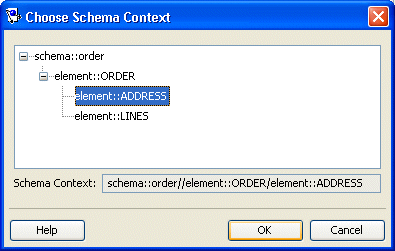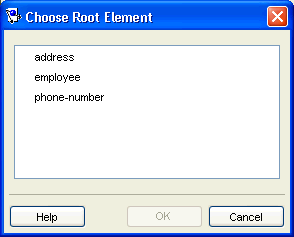Notice: This Wiki is now read only and edits are no longer possible. Please see: https://gitlab.eclipse.org/eclipsefdn/helpdesk/-/wikis/Wiki-shutdown-plan for the plan.
Configuring an EIS Descriptor (ELUG)
![]() For the latest EclipseLink documentation, please see http://www.eclipse.org/eclipselink/documentation/
For the latest EclipseLink documentation, please see http://www.eclipse.org/eclipselink/documentation/
Contents
For information on how to create EIS descriptors, see Creating an EIS Descriptor.
This table lists the default configurable options for an EIS descriptor.
1 EIS root descriptors only (see Configuring an EIS Descriptor as a Root or Composite Type).
For more information, see Introduction to EIS Descriptors.
Configuring Schema Context for an EIS Descriptor
Workbench uses the schema context to associate the class that the EIS descriptor describes with a simple or complex type in one of the schemas associated with the EIS project (see How to Configure an XML Schema Reference). This allows Workbench to display the appropriate attributes available for mapping in that context.
You must configure the schema context for an EIS root descriptor (see Configuring an EIS Descriptor as a Root or Composite Type) only if you are using the Workbench.
How to Configure Schema Context for an EIS Descriptor Using Workbench
To associate an EIS descriptor with a simple or complex type in this project's schema, use this procedure:
- Select an EIS descriptor in the Navigator. Its properties appear in the Editor.
- Click the Descriptor Info tab. The Descriptor Info tab appears.
Descriptor Info Tab, Schema Context Option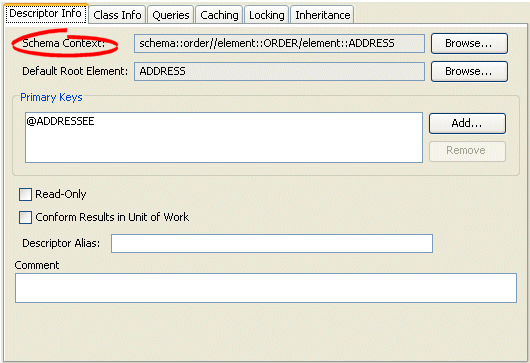
- Complete the Schema Context option on the tab.
- Click Browse to select the schema element to associate with this descriptor. For more information, see Configuring a Schema Context.
Choosing a Schema Context
Use the Choose Schema Context dialog box to select a specific schema element (such as when mapping an element).
Choose Schema Context Dialog Box
Select the schema element and click OK.
How to Configure Schema Context for an EIS Descriptor Using Java
For an EIS descriptor, the EclipseLink runtime does not need the schema context: the runtime can determine the schema context based on the mappings you configure on the descriptor. No further configuration is required.
Configuring Default Root Element
You must configure the default root element for EIS Root Descriptors so that the EclipseLink runtime knows the data source data type associated with the class the descriptor describes. Descriptors used only in composite relationship mappings do not require a default root element.
|
Note: Although you select an element from your project's schema to configure this attribute, you are choosing the element's simple or complex type. |
For more information, see Default Root Element.
How to Configure Default Root Element Using Workbench
When you create an EIS project using Workbench, you must use XML records. Consequently, you must configure a default root element so that Workbench knows what element to start with when persisting an instance of the class that the EIS descriptor describes.
To specify a schema element as the default root element for the descriptor, use this procedure:
- Select a descriptor in the Navigator. Its properties appear in the Editor.
- Click the Descriptor Info tab. The Descriptor Info tab appears.
Descriptor Info Tab, Default Root Element Option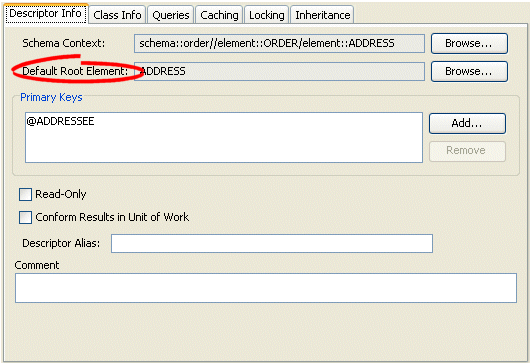
- Use the Default Root Element option to select the root element for this descriptor. Click Browse to select the schema element to identify as the root element. See Configuring a Root Element for more information.
Choosing a Root Element
Use the Choose Root Element dialog box to select a specific root element.
Choose Root Element Dialog Box
Select the root element and click OK.
How to Configure Default Root Element Using Java
When you create an EIS project using Java code, use the EISDescriptor method setDataTypeName to specify the XML schema complex type name (if you are using XML records) or the JCA record name (if you are using indexed or mapped records) corresponding to the class that the EIS descriptor describes. For more information, see EclipseLink API Reference.
Configuring Record Format
The EIS descriptor record format determines the EIS record type to which the descriptor's EIS mappings map.
When you create an EIS project using Workbench, EclipseLink configures all EIS descriptors with a record format of XML.
When you create an EIS project in Java, you can configure the EIS descriptor record type to any of the supported types, as this table shows.
| EISDescriptor Method | EIS Record Type |
|---|---|
|
useMappedRecordFormat |
All EIS mappings owned by this descriptor map to EIS mapped records. |
|
useIndexedRecordFormat |
All EIS mappings owned by this descriptor map to EIS indexed records. |
|
useXMLRecordFormat |
All EIS mappings owned by this descriptor map to EIS XML records.If you use the XML record format, you must specify one or more XML schemas in your EIS project (see How to Import an XML Schema). The EclipseLink runtime performs XML data conversion based on one or more XML schemas. In an EIS XML project, Workbench does not directly reference schemas in the deployment XML, but insteadexports mappings configured with respect to the schemas you specify. For information on EclipseLink support for XML namespaces, see XML Namespaces. |
For more information, see EIS Record Type.
How to Configure Record Format Using Java
To configure the EIS record format for an EIS descriptor, use one of the EISDescriptor methods listed in the EIS Record Formats table, as shown in this example.
Configuring EISDescriptor Record Format
EISDescriptor descriptor = new EISDescriptor(); descriptor.useIndexedRecordFormat();
Configuring Custom EIS Interactions for Basic Persistence Operations
You can use EclipseLink to define an interaction for each basic persistence operation (insert, update, delete, read object, read all, or does exist) so that when you query and modify your EIS-mapped objects, the EclipseLink runtime will use the appropriate EIS interaction instead of the default EIS interaction.
You can configure custom EIS interactions for basic persistence operations only for EIS descriptors designated as root descriptors ( Configuring an EIS Descriptor as a Root or Composite Type).
Using Workbench, you can create XMLInteraction objects, in which there is a single query per interaction (see How to Configure Custom EIS Interactions for Basic Persistence Operations Using Workbench).
Using Java, you can create any EISInteraction type. For some EIS projects, it is common for multiple interactions to be used in a single query. For example, one interaction–to enqueue a request, and another–to dequeue the response. Because Workbench does not support setting multiple interactions on a single query, you must use an amendment method to create and configure the interaction in Java (see How to Configure Custom EIS Interactions for Basic Persistence Operations Using Java).
|
Note: In a one-to-one or one-to-many EIS mapping, you must also specify a selection interaction that EclipseLink uses to acquire target objects. You can use either the target object's read interaction (the default) or specify a separate selection interaction, if necessary. For more information, see Configuring Selection Interaction). |
How to Configure Custom EIS Interactions for Basic Persistence Operations Using Workbench
To configure custom EIS interactions for basic persistence operations, use the following procedure:
- In the Navigator, select an EIS root descriptor in a EIS project.
- Click the Queries tab in the Editor. The Queries tab appears.
- Click the Custom Calls tab. The Custom Calls tab appears.
Queries, Custom Calls Tab for EIS Calls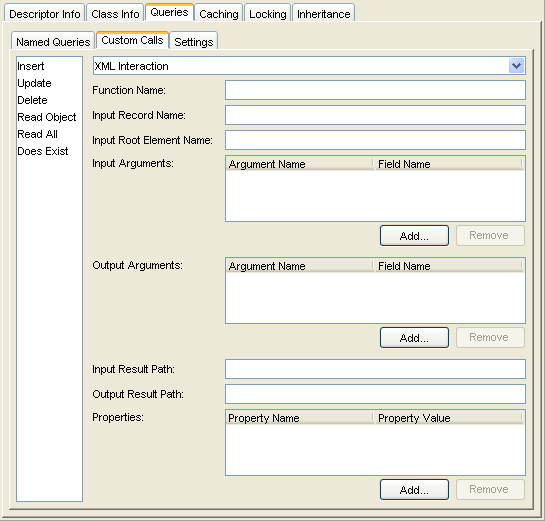
- Click the appropriate interaction type from the list (Insert, Update, Delete, Read Object, Read All, or Does Exist) and use the following table to enter data in each field
| Field | Description |
|---|---|
| Interaction Type | Using Workbench, you can only use XML Interactions. You cannot change this field. |
| Function Name | The name of the EIS function that this call type (Read Object or Read All) invokes on the EIS. |
| Input Record Name | The name passed to the JCA adapter when creating the input record. |
| Input Root Element | The root element name to use for the input DOM. |
| Input Arguments |
The query argument name to map to the interaction field or XPath nodes in the argument record. For example, if you are using XML records, use this option to map input argument name to the XPath name/first-name. |
| Output Arguments |
The result record field or XPath nodes to map to the correct nodes in the record used by the descriptor's mappings. For example, if you are using XML records, use this option to map the output fname to name/first-name.Output arguments are not required if the interaction returns an XML result that matches the descriptor's mappings. |
| Input Result Path |
Use this option if the EIS interaction expects the interaction arguments to be nested in the XML record. For example, specify arguments, if the arguments were to be nested under the root element exec-find-order, then under an arguments element. |
| Output Result Path |
Use this option if the EIS interaction result record contains the XML data that maps to the objects in a nested structure. For example, specify order, if the results were return under a root element results, then under an order element. |
| Properties | Any properties required by your EIS platform. For example, property name operation (from AQPlatform.QUEUE_OPERATION) and property value enqueue (from AQPlatform.ENQUEUE). |
How to Configure Custom EIS Interactions for Basic Persistence Operations Using Java
Using Java, you can create any type of EIS interaction that EclipseLink supports.
For some EIS projects, it is common for multiple interactions to be used in a single query: for example, one interaction to enqueue a request and another to dequeue the response. Because Workbench does not support setting multiple interactions on a single query, you must use an amendment method to create and configure the interaction in Java, as this examle shows.
Creating an XML Interaction for an AQ Platform
public static void addXMLInteractions(ClassDescriptor descriptor) {
// find order interaction
XMLInteraction request = new XMLInteraction();
request.setProperty(AQPlatform.QUEUE_OPERATION, AQPlatform.ENQUEUE);
request.setProperty(AQPlatform.QUEUE, "ORDER_INBOUND_QUEUE");
request.setProperty(AQPlatform.SCHEMA, "AQUSER");
request.setInputRootElementName("READ_ORDER");
request.addArgument("@id");
XMLInteraction response = new XMLInteraction();
response.setProperty(AQPlatform.QUEUE_OPERATION, AQPlatform.DEQUEUE);
response.setProperty(AQPlatform.QUEUE, "ORDER_OUTBOUND_QUEUE");
response.setProperty(AQPlatform.SCHEMA, "AQUSER");
ReadObjectQuery query = new ReadObjectQuery();
query.addCall(request);
query.addCall(response);
descriptor.getQueryManager().setReadObjectQuery(query);
// place order interaction
XMLInteraction insert = new XMLInteraction();
insert.setProperty(AQPlatform.QUEUE_OPERATION, AQPlatform.ENQUEUE);
insert.setProperty(AQPlatform.QUEUE, "ORDER_INBOUND_QUEUE");
insert.setProperty(AQPlatform.SCHEMA, "AQUSER");
insert.setInputRootElementName("INSERT_ORDER");
descriptor.getQueryManager().setInsertCall(insert);
}
Configuring an EIS Descriptor as a Root or Composite Type
You can designate an EIS descriptor as root or composite.
When you designate an EIS descriptor as a root, you tell the EclipseLink runtime that the EIS descriptor's reference class is a parent classš–no other class will reference it by way of a composite object mapping or composite collection mapping. Using an EIS root descriptor, you can configure all supported mappings and you can configure the descriptor with EIS interactions. However, if you configure the EIS root descriptor with a composite object mapping or composite collection mapping, the reference descriptor you define must be an EIS composite descriptor; it cannot be another EIS root descriptor.
When you designate an EIS descriptor as a composite (the default), you tell the EclipseLink runtime that the EIS descriptor's reference class may be referenced by a composite object or composite collection mapping. Using an EIS composite descriptor, you can configure all supported mappings, but you cannot configure it with EIS interactions.
You can configure inheritance for a descriptor designated as a composite (see Configuring Inheritance for a Child (Branch or Leaf) Class Descriptor), however, in this case, all the descriptors in the inheritance tree must be aggregates. Aggregate and class descriptors cannot exist in the same inheritance tree. For more information, see Aggregate and Composite Descriptors and Inheritance.
If you configure a descriptor as a composite using Workbench, you cannot configure the descriptor with EJB information.
For more information, see the following:
How to Configure an EIS Descriptor as a Root or Composite Type Using Workbench
To configure an EIS descriptor as a root or composite EIS descriptor, use this procedure:
- In the Navigator, select an EIS composite descriptor.
- Click the Root or Composite descriptor button on the mapping toolbar.You can also select the descriptor and choose Selected > Descriptor Type > Root or Composite from the menu or by right-clicking on the descriptor in the Navigator and selecting Descriptor Type > Root or Composite from the context menu.
How to Configure an EIS Descriptor as a Root or Composite Type Using Java
To configure an EIS descriptor as root or composite using Java, create a descriptor amendment method (see Configuring Amendment Methods) and use the following EISDescriptor methods:
- To designate an EIS descriptor as a root descriptor, use EISDescriptor method descriptorIsNormal.
- To designate an EIS descriptor as a composite (nonroot) descriptor, use EISDescriptor method descriptorIsAggregate.

